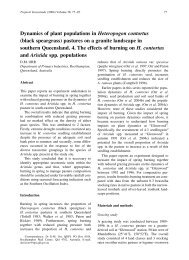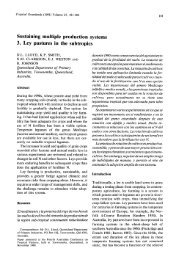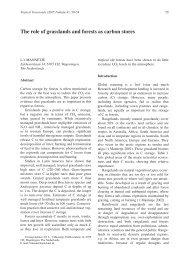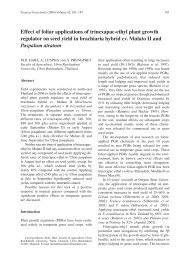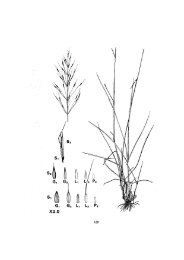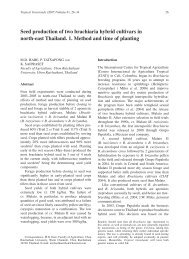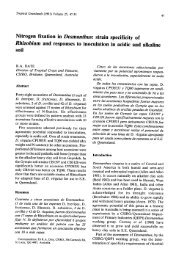Utilisation of ley legumes as livestock feed in Zimbabwe - Tropical ...
Utilisation of ley legumes as livestock feed in Zimbabwe - Tropical ...
Utilisation of ley legumes as livestock feed in Zimbabwe - Tropical ...
You also want an ePaper? Increase the reach of your titles
YUMPU automatically turns print PDFs into web optimized ePapers that Google loves.
<strong>Utilisation</strong> <strong>of</strong> <strong>ley</strong> <strong>legumes</strong> <strong>in</strong> <strong>Zimbabwe</strong> 85<br />
<strong>legumes</strong> that would be ideal for cereal-legume<br />
<strong>in</strong>tercropp<strong>in</strong>g systems. Substantial evidence<br />
h<strong>as</strong> been accumulated to show that <strong>ley</strong> farm<strong>in</strong>g<br />
is both fe<strong>as</strong>ible and potentially very beneficial<br />
for <strong>Zimbabwe</strong> (Muchadeyi 1998; Jiri 2003;<br />
Ma<strong>as</strong>dorp et al. 2004). However, there are few<br />
examples <strong>of</strong> legume-b<strong>as</strong>ed <strong>ley</strong> farm<strong>in</strong>g systems<br />
that have been readily adopted by farmers <strong>in</strong><br />
<strong>Zimbabwe</strong>. Three species, namely: Lablab purpureus<br />
(lablab), Mucuna pruriens (velvet bean)<br />
and Vigna unguiculata (cowpea), have been successfully<br />
established, ma<strong>in</strong>ly to <strong>feed</strong> dairy cattle<br />
under different climatic and management conditions<br />
(Majee and Chikumba 1995; Muchadeyi<br />
1998; Nyoka et al. 2004) (Table 1). Crotalaria<br />
juncea (sunnhemp), Glyc<strong>in</strong>e max (soybean)<br />
Vicia sativa (vetch), Pisum sativum (pea) and<br />
Lup<strong>in</strong>us albus (white lup<strong>in</strong>) have been used to<br />
a lesser extent, and research on these species<br />
<strong>in</strong> <strong>Zimbabwe</strong> is limited. Despite little attention<br />
be<strong>in</strong>g given to the afore-mentioned species, they<br />
have shown a lot <strong>of</strong> potential <strong>in</strong> other tropical<br />
countries (Muchadeyi 1998). Hence, there is need<br />
to broaden the research agenda to <strong>in</strong>clude selection<br />
<strong>of</strong> these species, especially <strong>in</strong> smallholder<br />
are<strong>as</strong> <strong>of</strong> low agricultural potential.<br />
The follow<strong>in</strong>g attributes were used for<br />
screen <strong>in</strong>g and evaluation: e<strong>as</strong>e <strong>of</strong> establishment<br />
(high seed-production potential); e<strong>as</strong>e <strong>of</strong> reestablishment<br />
(high soil-seed-reserve potential,<br />
hardseededness); longevity; e<strong>as</strong>e <strong>of</strong> control dur<strong>in</strong>g<br />
the crop ph<strong>as</strong>e; high nitrogen-fixation potential (a<br />
function <strong>of</strong> plant productivity and soil adaptation);<br />
drought tolerance; tolerance <strong>of</strong> dise<strong>as</strong>es and pests;<br />
chemical composition; and animal production (a<br />
function <strong>of</strong> plant production and nutritive value)<br />
(Clatworthy and Madakadze 1988; Mutisi et al.<br />
1994). The selection criteria should be extended<br />
to <strong>in</strong>clude important parameters such <strong>as</strong>: nutrient<br />
uptake efficiency; species complementarity (<strong>as</strong>sociative<br />
ability); economics <strong>of</strong> <strong>ley</strong> legume production;<br />
and animal production factors such <strong>as</strong> <strong>in</strong> vivo<br />
digestibility, <strong>in</strong> vivo degradability and effects on<br />
milk yield, reproduction and growth rates.<br />
Gr<strong>as</strong>slands Research Station <strong>in</strong> Marondera<br />
identified Lablab purpureus cvv. Rongai and<br />
Highworth and ILCA Acc. 11642 <strong>as</strong> appropriate<br />
<strong>legumes</strong> for <strong>in</strong>tercropp<strong>in</strong>g <strong>in</strong> the high- potential<br />
agro-ecological communal are<strong>as</strong> <strong>of</strong> <strong>Zimbabwe</strong><br />
(Manyawu et al. 1993; Manyawu 1998). Grown<br />
alone, Rongai and Jhansi gave the highest forage<br />
yields (5.9 and 5.85 t/ha DM) and were ideal<br />
for use <strong>as</strong> annual or bi-annual fodder banks<br />
(Manyawu et al. 1993; J<strong>in</strong>gura et al. 2001). However,<br />
Highworth produced the highest gra<strong>in</strong> and<br />
forage yields <strong>in</strong> semi-arid agro-ecological zones<br />
<strong>of</strong> <strong>Zimbabwe</strong> (Mutisi et al. 1994). In order to<br />
realise full benefits from lablab, there is a need to<br />
control dise<strong>as</strong>es and pests (aphids and cutworms)<br />
(Manyawu et al. 1993). Therefore, it is important<br />
to select lablab accessions for resistance to not<br />
only bacterial and fungal dise<strong>as</strong>es but also pest<br />
attack.<br />
Prelim<strong>in</strong>ary f<strong>in</strong>d<strong>in</strong>gs from on-farm research <strong>in</strong><br />
Chihota communal lands and Makaholi Research<br />
Station <strong>in</strong>dicated that Mucuna pruriens and Vigna<br />
unguiculata produced high yields <strong>in</strong> warmer and<br />
medium-high ra<strong>in</strong>fall are<strong>as</strong> with poor soil fertility<br />
<strong>in</strong> <strong>Zimbabwe</strong> (Majee and Chikumba 1995;<br />
Jiri 2003) (Table 1). Vigna unguiculata accession<br />
121688 gave the highest forage dry matter yield<br />
(2.38 t/ha) after one se<strong>as</strong>on’s growth <strong>in</strong> studies<br />
conducted <strong>in</strong> Hwedza (Manyawu 1998; Mur<strong>in</strong>gweni<br />
et al. 2004).<br />
Selection <strong>of</strong> tropical <strong>legumes</strong> for <strong>ley</strong>s h<strong>as</strong> concentrated<br />
largely on the three above-mentioned<br />
species rather than on systematic screen<strong>in</strong>g <strong>of</strong><br />
large germpl<strong>as</strong>m collections for suitability <strong>as</strong><br />
<strong>ley</strong>s. Thus, it is suggested that screen<strong>in</strong>g and<br />
evaluation programs should be expanded to<br />
<strong>in</strong>clude accessions/cultivars <strong>of</strong> <strong>legumes</strong> that are<br />
more efficient and require fewer establishment<br />
and management <strong>in</strong>puts than exist<strong>in</strong>g species and<br />
cultivars. Different germpl<strong>as</strong>m options should<br />
Table 1. Climatic and edaphic attributes <strong>of</strong> common <strong>ley</strong> legume species and cultivars used <strong>in</strong> crop-<strong>livestock</strong> systems <strong>in</strong> <strong>Zimbabwe</strong>.<br />
Species Common name Common cultivars Soil type Ra<strong>in</strong>fall (mm) Temperature (°C)<br />
Lablab purpureus Lablab Rongai, Highworth Deep sands to heavy clays



